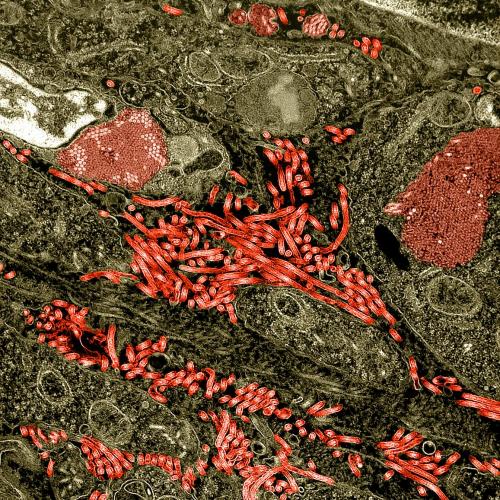Ebola virus infects reproductive organs in monkeys
Ebola virus can infect the reproductive organs of male and female macaques, suggesting that humans could be similarly infected. Prior studies of survivors of the 2014-2016 Ebola outbreak in West Africa have revealed sexual transmission of Ebola virus, and that viral RNA (Ebola virus genetic material) can persist in semen following recovery. While little is known about viral persistence in female reproductive tissues, pregnant women with Ebola virus disease have a maternal death rate of more than 80 percent and a fetal death rate of nearly 100 percent.

Colorized transmission electron micrograph of the ovary from a nonhuman primate infected with Ebola virus. Characteristic filamentous Ebola virus particles are present between cells (bright red). Intracytoplasmic Ebola virus inclusion bodies forming crystalline arrays can be seen within ovarian stromal cells (darker red).
In this study, investigators from the National Institute of Allergy and Infectious Diseases (NIAID), part of the National Institutes of Health, and from Thomas Jefferson University infected four female and eight male macaques with the Makona variant of Ebola virus, the variant responsible for the recent West Africa outbreak. All the macaques succumbed to Ebola virus disease and were euthanized six to nine days after infection. The scientists then took reproductive tissue samples from each macaque and analyzed the samples for signs of Ebola virus infection, organ and tissue damage, and immune responses. They found widespread Ebola virus infection of reproductive organs with minimal tissue immune response or signs of disease.
Based on the findings, the authors hypothesize that Ebola virus can persist in these tissues in human survivors, and that the virus may reach seminal fluid in men by infecting immune cells called tissue macrophages. However, it is unclear if the detection of Ebola virus RNA in semen documented in human studies means that infectious virus is present. The authors note that additional research is needed to learn how Ebola virus persists in these sites, to determine if drugs and vaccines can cure or prevent such infections, and to understand the mechanisms of sexual transmission, including why it appears to occur only rarely in people. To do this, NIAID scientists are developing a new nonhuman primate model of Ebola virus disease in which monkeys survive infection. Few macaques survive in the current model, making it difficult to study virus persistence and its long-term impacts.
Source: U.S. National Institutes of Health
- 274 reads
Human Rights
Ringing FOWPAL’s Peace Bell for the World:Nobel Peace Prize Laureates’ Visions and Actions

Protecting the World’s Cultural Diversity for a Sustainable Future

The Peace Bell Resonates at the 27th Eurasian Economic Summit

Declaration of World Day of the Power of Hope Endorsed by People in 158 Nations

Puppet Show I International Friendship Day 2020

